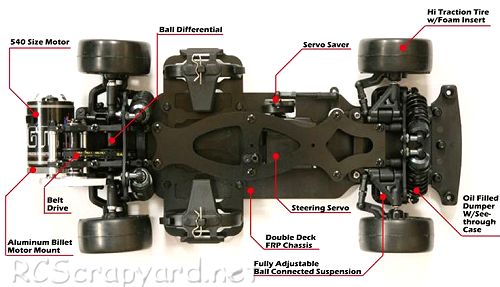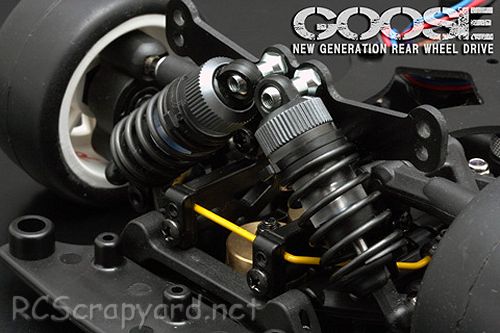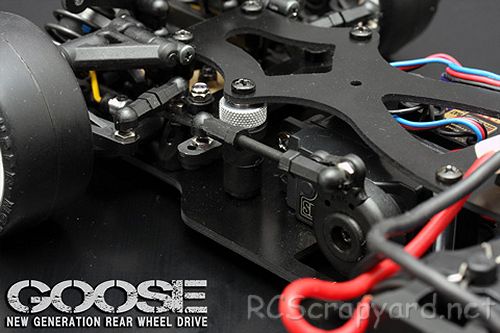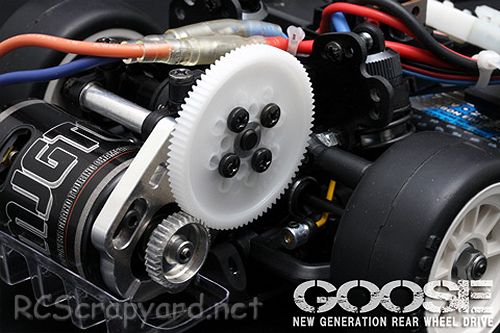

|
|
|


|
|
1/10 Scale Electric Rally/Touring Car:
ABC Hobby Goose - Radio Controlled ModelHistory and Info:
Introduced by ABC Hobby circa 2009, the 2WD TTR Goose Chassis, is Rear Wheel Drive and was available as a Street Racer (without bodyshell) - # 25000, or with a number of bodyshell options, including: Toyota Sports 800 - # 25001, Toyota MR2 - # 25002, Toyota Sports 800 Racing Version - # 25003, Nissan Sunny Coupe - # 25511, BRE Datsun 510 - # 25513, Maruzen Technica Tomei Sunny - # 25514, BRE Datsun 240Z - # 25515, Toyota Celica Coupe 1600 GT - # 25516, Datsun 240Z (S30) - # 25517, Toyota Corolla Levin (TE27) - # 25518, Toyota Celica Liftback 2000GT - # 25519.
▼ Scroll Down for More Images ▼
|








|
|
|

★ ABC Hobby Goose Chassis ★

★ ABC Hobby Goose Chassis ★

★ ABC Hobby Goose Chassis ★

★ ABC Hobby Goose Chassis ★

|
Buying a Used ABC Hobby Goose
|
|
Manufacturers and Brands Catalogued, Listed and Reviewed by RC-Scrapyard.
At present, the RC Model Manufacturers, Brands and Distributors covered by us are: ABC Hobby, Academy, Acme Racing, Agama Racing, Amewi, Ansmann Racing, ARRMA, Team Associated, Atomic RC, Axial, AYK, Bolink, BSD Racing, Capricorn, Carisma, Carson, Caster Racing, Cen, Corally, Custom Works, Durango, Duratrax, ECX - Electrix, Exceed RC, FG Modellsport, FS-Racing, FTX, Fujimi, Gmade, GS-Racing, Harm, HBX, Helion, Heng Long, Himoto Racing, Hirobo, Hitari, Hobao, Hong-Nor, Hot Bodies, HPI, HSP, Intech, Integy, Jamara, JQ Products, Kawada, Kyosho, Losi, LRP, Maisto, Mardave, Marui, Maverick, MCD Racing, Megatech, Mugen, New Bright, Nichimo, Nikko, Nkok, Ofna, Pro-Pulse, Protech, PTI, RC4WD, Redcat Racing, RJ-Speed, Robitronic, Schumacher, Seben, Serpent, Smartech, Sportwerks, Step-Up, Tamiya, Team-C Racing, Team Magic, Thunder Tiger, Tomy, Top Racing, Traxxas, Trinity, Tyco, Vaterra RC, Venom, VRX Racing, WLToys, X-Factory, Xmods, Xpress, Xray, XTM, Yankee RC, Yokomo, ZD Racing and Zipzaps. |
Information and AdviceElectronic Speed ControllersHistory
ESC were originally developed to be used in conjunction with brushed 27T stock and modified motors in the late 1970s, early 1980s. Compared to modern day Controllers, they were Bulky and heavy, constructed using basic resistors, rheostats, capacitors and transistors, crammed together on a simple circuit board, to provide stepped but smooth acceleration when compared to the old mechanical, servo operated sweeper Speed Controllers. An Electronic Switch to change the direction of current flow was used on some of these early ESC to give reverse operation. Although they were a vast improvement on the old mechanical speedos of the time, they were expensive, jerky to control, and prone to burn out if not carefully looked after. |
|
Hints, Tips and Information
Driving On Road
The basic driving style most commonly used for all forms of on road, tarmac and carpet racing, involves using the full width of the road available, and cutting each apex as tight as possible, whilst keeping complete control of the car on the track. The style, often referred to as "Rounding" looks quite simple to those watching, but to get it right needs good hand eye coordination and lots of practice. |
|
RC Models:
|
Radio & Motors: |
Other
Accessories: |